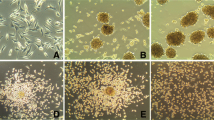Summary
-
1.
A human glioma cell line, NG97, was established by Grippo et al. in 2001 from tissue obtained from a grade III astrocytoma (WHO, 2000). In this first study, the cell line grew as two morphologically distinct subpopulations: dendritic/spindle cells and small round cells. The injection of NG97 cells into nude mice induced an aggressive tumor characterized by: severe cytological atypia, vascular proliferation and pseudopalisading necrosis (glioblastoma multiforme features).
-
2.
The purpose of the present study was to characterize the immunophenotype and ultrastructural aspects of this cell line, using the parental tumor, cultured cells and the xenotransplant, in order to assess its glial nature and possible divergent differentiation.
-
3.
NG97 cells and xenotransplant expressed the main neuroglial markers (GFAP, S-100 protein, NSE and Leu-7) and showed no aberrant expression of other histogenetic markers. GFAP was similarly expressed in the parental tumor and in the cells in culture, but decreased in the xenotransplant. NSE expression was reduced in NG97 cells, but substantially recovered in the xenotransplant. This variability in expression of GFAP and NSE was interpreted as either a phenomenon of dedifferentiation or to microenvironmental selection of specific subclones. S-100 was equally expressed in the three contexts. The xenotransplant’s ultrastructural features were those of a highly undifferentiated tumor. No significant immunophenotypic or ultrastructural differences between the two morphologically distinct populations were found.
-
4.
Thus, our data demonstrate that NG97 cells constitute a pure glial-committed cell line, which may prove useful as a malignant glioma model in studies addressing pathophysiological, diagnostic and therapeutic issues.
Similar content being viewed by others
References
Cavenee, W. K., Furnari, F. B, Nagane, M., et al. (2000). Diffusely infiltrating astrocytomas. In Kleihues P. & Cavenee, W. K. (eds.), WHO’s Pathology & Genetics of Tumours of Nervous System. IARC Press, Lyon, France.
Chauvenic, L., Sola-Martinez, M. T., Martin-Duverneuil, M., et al. (1996). Intraarterial chemotherapy with ACNU and radiotherapy in inoperable malignant gliomas. J. Neuro-oncol. 27:141–147.
Damek, D. M., and Hochberg, F.,H. (1997). Clinical aspects of brain tumor. Curr. Opin. Neurol. 10:452–458.
Diserens, A. C., Tribolet, N., Martin-Achard, A., Gaide, A. C., Schnegg, J. F., and Canel, S. (1981). Characterization of an established human malignant glioma cell line: LN-18. Acta Neuropathol. (Berl) 53:21–28.
Ellison, D., Love, S., Chimelli, L., et al. (1998). Neuropathology; A reference text of CNS pathology. Mosby, London, pp. 35:1–35.10.
Erlandson, R. A. (1994). Diagnostic Transmission Electron Microscopy of Tumors with Clinicopathological, Immunohistochemical and Cytogenetic Correlations. Ranven Press, New York, pp. 388–396.
Grippo, M. C., Penteado, P. F., Carelli, E. F., Cruz-Höfling, M. A., and Verinaud, L. (2001). Establishment and partial characterization of a continuous human malignant glioma cell line: NG97. Cell. Mol. Neurobiol. 21(4):421–428.
Kleihues, P., Burger, P. C., Collins, V. P., Newcomb, E. W., Ohgaki, H., and Cavenee, W. K. (2000). Glioblastoma. In Kleihues P., and Cavenee, W. K. (eds.), WHO’s Pathology and Genetics of Tumours of Nervous System. IARC Press, Lyon, France.
Kruse, C. A., Varella-Garcia, M., and Kleischmidt-Demasters, B. K., et al. (1998). Receptor expression, cytogenetic, and molecular analysis of six continuous human glioma cell lines. In Vitro Cell. Dev. Biol.—Animal 34:455–462.
Laerum, O. D., Steinsvag, S., and Bjerkvig, R. (1985). Cell and tissue culture of the central nervous system: recent developments and current applications. Acta Neurol. Scand. 72:529–549.
Laws, Jr. E. R., and Thapar, K. (1993). Brain tumors. CA: A Cancer J. Clin. 43:263–271.
Linskey, M. E., and Gilbert, M. R. (1995). Glial differentiation: A review with implications for new directions in neuro-oncology. Neurosurgery 36(1): 1–21.
Metze, K., and Andrade, L. A. L. A. (1991). Atypical stromal giant cells of cervix uteri—evidence of schwann cell origin. Pathol. Res. Pract. 187:1031–1035.
Nederman, T. (1984). Effect of vinblastine and 5-fluorouracil on human glioma and thyroid cancer cell monolayers and spheroids. Cancer Res. 3:209–212.
Michailowsky, C., Niura, F. K., do Valle, A. C., et al. (2003). Experimental tumors of the central nervous system: standardization of a model in rats using the 9L glioma cells. Arquivos de Neuropsiquiatria 61(2A): 234–240.
Morrison, C. D., and Prayson, R. A. (2000). Immunohistochemistry in the diagnosis of neoplasms of the central nervous system. Semin. Diagn. Pathol. 17(3): 204–215.
Prados, M. D., and Levin, V. (2000). Biology and treatment of malignant glioma. Semin. Oncol. 27(3, suppl 6):1–10.
Saroja, K. R., Mansell, J., Hendrikson, F. R., Cohen, L., and Lenox, A. (1989). Failure of accelerated neutron therapy to control high grade astrocytomas. Int. J. Radiat. Oncol. Biol. Phys. 17:1295–1297.
Schiffer, D., Giordana, M. T., and Germano, I., et al. (1986). Anaplasia and heterogeneity of GFAP expression in gliomas. Tumori 72:163–170.
Solimene, A. C. C, Carneiro, C. R. W., Melati, I., and Lopes, J. D. (2001). Functional differences between two morphologically distinct cell subpopulations within a human colorectal carcinoma cell line. Brazilian J. Med. Biol. 34:653–661.
Takeshita, I., Sawa, H., Nakamura, T., Kuramitsu, M., Kitamura, K., and Fukui, M. (1990). Contrary effect of lactic acid expression of neuron-specific enolase and glial fibrillary acidic protein in human glioma cells. Acta Neuropathol. (Berl) 79(5):506–512.
Trentin, A. G., and Alvarez-Silva, M. (1998). Thyroid hormone regulates protein expression in C6 glioma cells. Brazillian J. Med. Biol. Res. 31:1281–1284.
Welch, W. C., Morrison, R. S., Gross, J. L., Goclin, S. M., Kitson, R. B., Goldfarb, R. H., Giuliano, K. A., Bradley, M. K., and Kornblith, P. L. (1995). Morphologic, immunophenotypic, biochemical, and cytogenetic characteristics of the human glioblastoma-derived cell line, SNB-19. In Vitro Cell. Dev. Biol.—Animal 31:610–616.
Author information
Authors and Affiliations
Rights and permissions
About this article
Cite this article
Schenka, A.A., Machado, C.M.L., Grippo, M.C. et al. Immunophenotypic and Ultrastructural Validation of a New Human Glioblastoma Cell Line. Cell Mol Neurobiol 25, 929–941 (2005). https://doi.org/10.1007/s10571-005-4959-1
Received:
Accepted:
Issue Date:
DOI: https://doi.org/10.1007/s10571-005-4959-1




